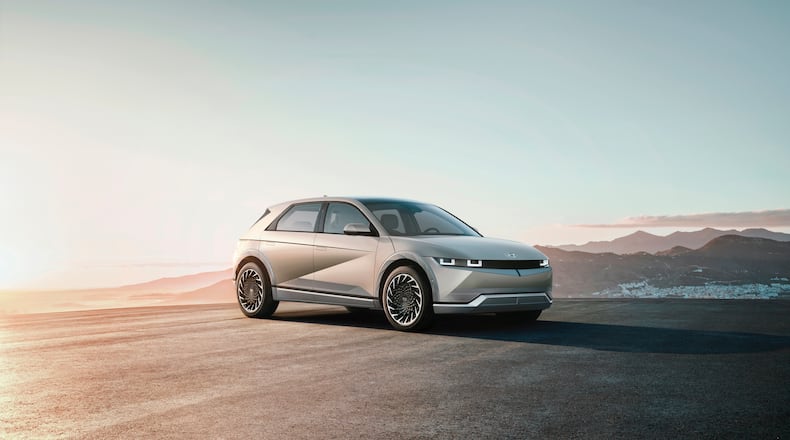You can also search for hundreds more trim versions of those models. (Pro tip: Be sure to check out the Customize button on the upper right. You can filter by state — some states offer EV credits — and game out operating costs based on higher or lower costs for gas, diesel, electricity and hydrogen.)
Drive today below 2030 emission goals
There aren’t any gas or diesel models with emission profiles at or below the 2030 target.
Credit: Ng Han Guan
Credit: Ng Han Guan
But according to Carboncounter.com there are nearly four dozen EV and hybrid models whose estimated carbon footprint is already at or below the 2030 emissions goal for the average car. That target is based on limiting the global temperature rise to 2 degrees Celsius. There are even a few all-electric models (Hyundai Ioniq and Tesla Model 3) that are below 2040 emission targets, and a handful more hovering right around the 2040 target.
Gone are the days when EV choices were mostly limited to compacts and mid-size sedans. Pick your size, and there’s likely more than a few EV/hybrid options to consider.
—Least expensive and environmentally friendly: MINI Cooper SE Hardtop 2 door electric. Its greenhouse gas emissions are estimated to be right at the 2040 target level. And the price (after the federal $7,500 tax credit) starts below $23,000. That said, the driving range per charge is 110 miles. The Nissan Leaf is a close second on emissions/price, with a 147-mile range.
— Best on emissions. Hyundai Ioniq electric. It has a 170-mile driving range and a starting price below $26,000 after the federal tax credit.
— Great on emissions with more driving range: Tesla 3 Standard Range Plus. Carbon footprint is already below the 2040 emissions target, and it has a driving range of 250 miles. The starting price is around $38,000. If you need more mileage per charge, the Tesla 3 Long Range clocks in at around 353 miles, but you pay for that extra battery juice: The starting price is around $47,000.
— Compact SUVs. There are six all-electric models with estimated greenhouse emissions at or below the 2030 target. The most wallet-friendly electric compact SUV is the Hyundai Kona Electric. It is better on emissions and less expensive than the new Volkswagen ID.4 that has been grabbing headlines. If you want an all-wheel drive experience, the Tesla Model Y Long Range (320-plus miles) has a starting base price that is about $10,000 less than the Tesla Model Y Performance model. For hybrid enthusiasts, no full hybrid currently is below the 2030 emissions target. But two hybrid plug-ins are: the Toyota RAV 4 Prime 4WD and Subaru Crosstrek Hybrid AWD.
— Full/midsize SUV. The only model that is already below the 2030 emission target is the all-electric Audi Q4 e-tron. The Volvo XC90 AWD plug-in hybrid has the next-best emissions output, though it is above the 2030 target.
— Minivan: The Chrysler Pacifica Hybrid slightly edges out the Toyota Sienna Hybrid 2D on both emissions and price, though neither is yet at the 2030 emissions target (but pretty darn close).
New car buyers are increasingly opting for electric vehicles (EVs) and hybrids. An analysis by Cox Automotive and Kelley Blue Book estimates that nearly 8% of sales in the first quarter were either full-on EVs, or hybrids, up from 4.8% a year earlier.
If you need a car pronto (and insist on new, even though used cars are a much smarter financial choice, an EV that qualifies for a federal tax credit is an option to consider.
But if you can wait, it is anticipated that as early as 2023, falling EV battery production costs will push EV sticker prices down to the level of traditional internal combustion engine (gas) cars.
©2021 Rate.com. Visit at rate.com. Distributed by Tribune Content Agency, LLC.
Credit: AP
Credit: AP
About the Author


